This article originally appeared in the Wall Street Journal:
By Betsy McKay: Updated Feb. 22, 2020 10:06 am ET
Concern is high about a dangerous new coronavirus behind an epidemic in China and illnesses in 26 other countries. The number of people sick with or dying of a viral pneumonia caused by the virus is still rising in the epicenter of Hubei Province, China, despite a quarantine of some 60 million people and other measures to stop it.
International health officials are also worried about growing clusters of illness elsewhere, including among people who have neither been to China nor in contact with anyone who has. Most cases outside China were part of an outbreak on the Diamond Princess cruise ship in Japan. The epidemic has interrupted travel and business and disrupted supplies of some goods—including those needed to fight the epidemic.
Scientists and public-health officials are learning more all the time about the virus, called Severe Acute Respiratory Syndrome Coronavirus 2, or SARS-CoV-2. The disease it causes is called Covid-19.
Among key questions they are seeking answers to are how the virus is transmitted, how easily it spreads and how many people are infected but don’t develop symptoms.
Here is what they know so far.
What is a coronavirus?
This new virus belongs to a family of viruses known as coronaviruses. Named for the crown-like spikes on their surfaces, they infect mostly bats, pigs and small mammals. But they mutate easily and can jump from animals to humans, and from one human to another. In recent years, they have become a growing player in infectious-disease outbreaks world-wide.
Seven strains are known to infect humans, including this new virus, causing illnesses in the respiratory tract. Four of those strains cause common colds. Two others, by contrast, rank among the deadliest of human infections: severe acute respiratory syndrome, or SARS, and Middle East respiratory syndrome, or MERS.
Coronaviruses: From Animals to Humans
Researchers aren’t sure how the novel coronavirus first infected people in China, but the viruses that cause SARS and MERS, which originated in bats, provide clues.
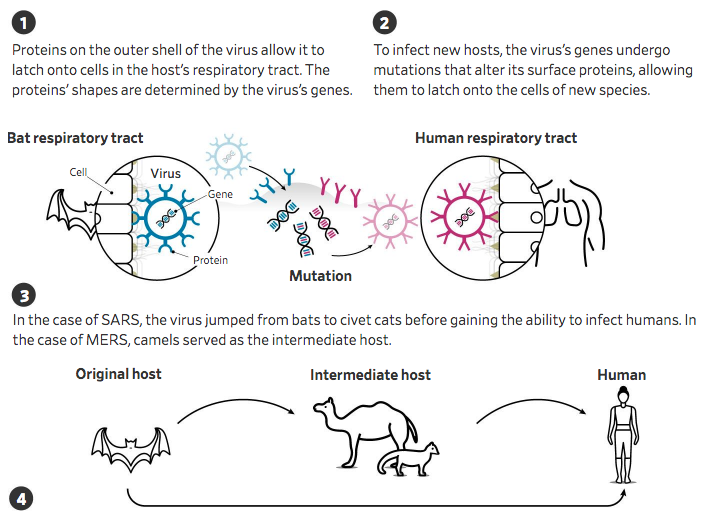
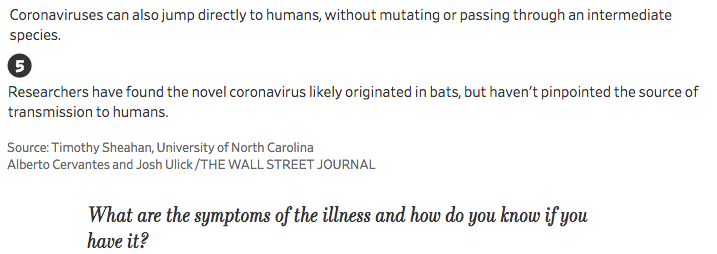
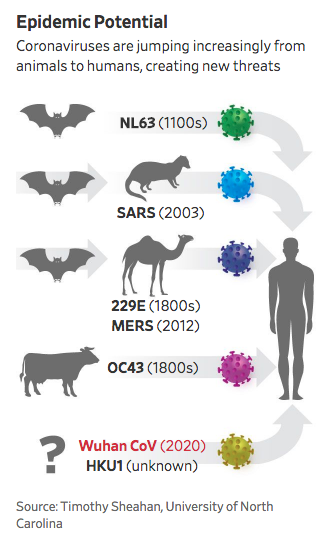
The virus infects the lower respiratory tract. Patients initially develop a fever, cough and aches, and can progress to shortness of breath and complications from pneumonia, according to case reports. They might develop nausea, with vomiting and diarrhea. Some become only mildly ill, or are infected but don’t get sick. Others are mildly ill for a few days, then rapidly develop more severe symptoms of pneumonia.
Some patients haven’t had a fever initially or might develop a “walking pneumonia,” meaning they might spread their infection to others because they aren’t sick enough to be in a hospital.
Who is most at risk?
Adults of all ages have been infected, but the risk is highest for older people and those with other health conditions such as diabetes. Most of the 1,023 people whose deaths were included in a study by the Chinese Center for Disease Control and Prevention were age 60 or older, and/or had other illnesses. Many patients who have died were admitted to hospitals when their illness was advanced. Few children have been reported with the infection, but that could change.
How at risk is someone in the U.S.?
The risk to the U.S. public is low, says the U.S. Centers for Disease Control and Prevention. There are very few cases in the U.S., and the virus isn’t spreading widely. The majority of confirmed infections are in people who were infected while abroad and were quarantined upon their return to the U.S.
The CDC is monitoring for more cases through reports from health-care providers and local public health departments, surveillance systems and testing.
How is the virus spread among humans?
It is likely spread through a cough, sneeze or other contact with saliva, Chinese officials say. There is no evidence of transmission by aerosol, or through the air. MERS and SARS spread mainly through “respiratory droplets” produced when someone coughs or sneezes. Those two viruses spread mostly through close contact.
Scientists are also investigating whether the new coronavirus may spread in feces, as tests have found it in the digestive tract of some patients.
What is the incubation period?
People become ill between two and 14 days after infection, according to the U.S. CDC. Chinese researchers recently cited an average incubation period of 5.2 days.
Is there a test?
Public-health officials have developed and are distributing diagnostic tests, which are being used to confirm whether a patient has the new coronavirus or another infection. In Hubei Province, cases are also being diagnosed based on chest X-rays and symptoms. Scientists are working on a blood test to detect antibodies to the virus, to determine how many people in the population have been infected. Some may not have gotten sick.
Can face masks protect you?
Health experts and mask makers say only a properly used reusable N95 respirator mask certified by an independent agency can guard against the virus. Paper or polyurethane foam masks don’t filter out smaller particles responsible for transmitting infectious agents. They may help prevent sick people from transmitting to others.
How Effective Are Masks?
The World Health Organization and other experts report that a mask’s efficacy in social settings is inconclusive. But some health experts and mask makers say that properly used, the N95 respirator mask can guard against the new coronavirus.
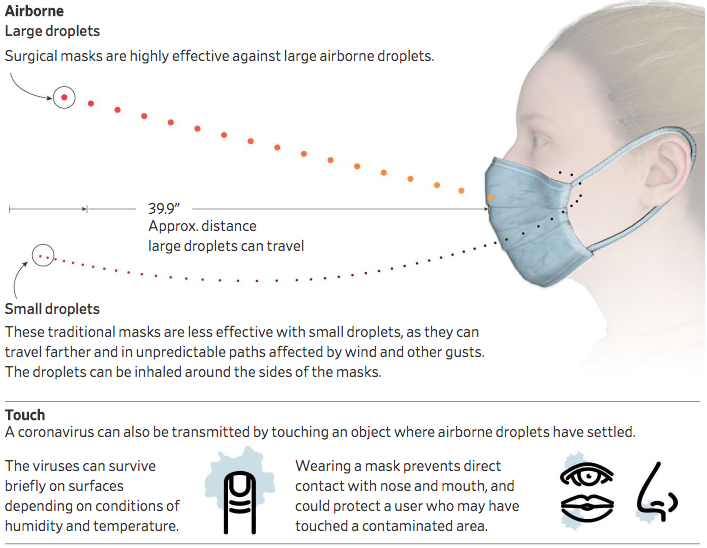
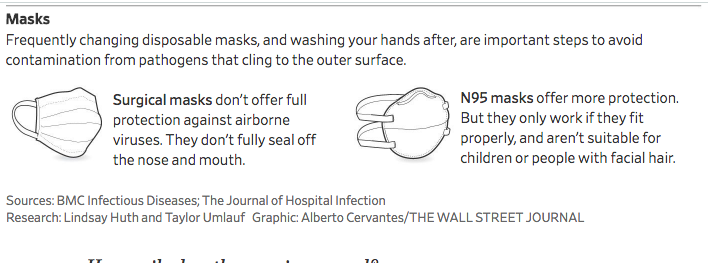
How easily does the new virus spread?
Disease-modeling experts have estimated that on average, each infected person has transmitted the virus to about 2.6 others, though the range is between 1.5 and 3.5. Those rates are higher than for some influenza viruses, some are lower than SARS, and they are far lower than measles, in which one infected person can transmit the virus to 12 to 18 other people.
Public-health experts caution that these estimates are preliminary, change over time and can be lowered by measures to prevent the virus from spreading.
Can you catch the virus from someone even before they have symptoms?
It is possible. But little is known so far. In Macau, a 15-year-old resident of Wuhan, the epicenter of the outbreak, tested positive for the coronavirus despite having no fever or cough, according to that special administrative region of China. Scientists reported in the Lancet medical journal that they identified the coronavirus in a 10-year-old boy who developed no symptoms, even though others in the child’s family fell ill. Chinese news outlets have reported a handful of other potential asymptomatic cases.
Where did the new coronavirus come from?
The new virus likely came originally from bats, scientists say. It isn’t known exactly where or how it jumped to humans, though. Viruses from bats often infect another mammal first and then mutate to become more transmissible to humans. One hypothesis is that the intermediary animal for this new virus may be a pangolin, a small mammal sold in wildlife markets, prized for its meat and scales covering its body.
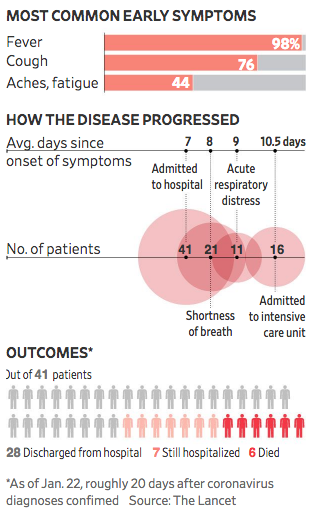
Health officials believe the outbreak originated in a large animal and seafood market in Wuhan, China.
Of the first 41 cases, 27 had some exposure to that market, according to a report in the Lancet. But three of the first four people to become ill, on Dec. 1 and Dec. 10, said they had no contact with the market.
A study in the New England Journal of Medicine found that 55% of patients in Wuhan who became ill before Jan. 1 had a link to the market, compared with 8.6% of those who became ill after that point. Scientists say it will take some time to identify the exact source.
How dangerous is the new coronavirus
It appears to be less deadly than a related pathogen—SARS, which erupted in China in 2002 and spread globally in 2003. SARS killed about 10% of the people it infected, while about 2.9% of the people confirmed to be infected with this new coronavirus have died, according to World Health Organization data.
But the new virus spreads from one person to another more easily than SARS, some disease modeling and case studies suggest.
Is the virus mutating, particularly in a way that would make it more contagious?
No. The virus has remained stable genetically thus far, according to the World Health Organization and the U.S. CDC.
How worried should I be?
Most people who are infected may become only mildly ill, data suggest. Of 44,672 cases in China, 81% had mild symptoms, 13.8% were severely ill, and 4.7% were critically ill, according to the Chinese CDC. All of those who died were in critical condition.

Public-health officials are trying to determine how many people have been infected, including those who didn’t get sick at all. They are concerned and want to contain the virus because its effects aren’t fully known. In addition, new viruses can mutate, possibly becoming more virulent as they work their way through a population.
Is it safe to travel to China?
The U.S. State Department has warned Americans not to travel to China. Most commercial airlines have suspended or reduced flights to and from China. Americans who remain in China should stay home as much as possible, limit contact with others and follow guidelines from the U.S. Centers for Disease Control and Prevention to prevent infection, U.S. authorities say.
Is it safe to go on a cruise?
The U.S. State Department has urged Americans to reconsider cruises to or within Asia, given the risk of infection and of being subjected to a lengthy quarantine.
Are there drugs to treat coronaviruses?
There aren’t any drugs or vaccines approved specifically for the new virus. But several are in development or being studied. Two clinical trials in China are evaluating remdesivir, an antiviral drug from Gilead Sciences Inc. that was also tested for Ebola.
A hospital in Wuhan is conducting a clinical trial using a combination of two drugs for HIV that had been tested on MERS patients in Saudi Arabia. The therapy, sold under the brand name Kaletra in the U.S., is normally used to treat HIV patients and belongs to a class of drugs known as protease inhibitors, which block a key enzyme that helps viruses replicate. In addition, a few vaccine makers are developing products targeting the virus.
What is being done to contain the spread of the virus?
China imposed quarantines on Wuhan, the epicenter of the outbreak, and several other cities, affecting millions of citizens. Officials built a large field hospital in Wuhan to isolate and care for patients and are investigating chains of transmission. It isn’t clear what effect the quarantine measures are having.
The U.S. imposed entry restrictions on foreign nationals who have visited China in the past 14 days. Most international airlines suspended flights from China. Americans who were evacuated from Hubei Province and a cruise ship where an outbreak occurred have undergone or are undergoing quarantines for 14 days.
There are few travelers from China currently. Those who do come to the U.S. are screened at the airport. Those who don’t have symptoms of illness are asked to self-quarantine for 14 days.
Could goods imported from China carry the virus?
That is unlikely, the CDC says. Coronaviruses generally don’t survive long on inanimate surfaces, according to the agency.









